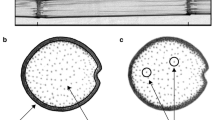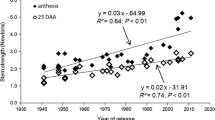Abstract
Stem lodging in Sorghum is a major agronomic problem that has far-reaching economic consequences. More rapid and reliable advances in stem lodging resistance could be achieved through development of selective breeding tools that are not dependent on post hoc data or dependent on abiotic or biotic environmental factors. Our objective was to use sorghum to examine how mechanical stability is achieved and lost, and to provide insights into the development of a rapid and reliable phenotyping approach. The biomechanical properties of the stems of six bioenergy sorghum genotypes were investigated using a three-point bending test protocol. Important morphometric data were also collected, and previously collected lodging scores were used to associate with morphological and mechanical traits. Nodes were two to three-folds stronger, stiffer, and more rigid than internodes. In general, internodes were numerically weakest and more rigid between internodes 3 and 6, corresponding to the area where higher stem lodging is observed. Internode strength was negatively correlated with diameter (r = −0.77, P < 0.05) and volume (r = 0.96, P < 0.01), while stem lodging was positively correlated with flexural rigidity (r = 0.85, P < 0.05) and volume (r = 0.78, P < 0.05). The analysis revealed key functional traits that influence the mode and location of stem lodging. Moreover, these results indicate the potential of these methods as a selective breeding tool for indirect selection of stem lodging resistance in bioenergy sorghum.









Similar content being viewed by others
References
Speck T, Burgert I (2011) Plant stems: functional design and mechanics. Annu Rev Mater Res 41:169–193
Gibson LJ (2012) The hierarchical structure and mechanics of plant materials. J R Soc Interface 9(76):2749–2766. doi:10.1098/rsif.2012.0341
Niklas KJ, Spatz H-C (2012) Plant physics. University of Chicago Press, Chicago
Wang X, Keplinger T, Gierlinger N, Burgert I (2014) Plant material features responsible for bamboo’s excellent mechanical performance: a comparison of tensile properties of bamboo and spruce at the tissue, fibre and cell wall levels. Ann Bot 114(8):1627–1635. doi:10.1093/aob/mcu180
Gardiner B, Berry P, Moulia B (2016) Review: Wind impacts on plant growth, mechanics and damage. Plant Sci 245:94–118
Berry P, Sterling M, Spink J, Baker C, Sylvester-Bradley R, Mooney S, Tams A, Ennos A (2004) Understanding and reducing lodging in cereals. Adv Agron 84:217–271
Niklas KJ (1992) Plant biomechanics: an engineering approach to plant form and function. University of Chicago Press, Chicago
Sterling M, Baker C, Berry P, Wade A (2003) An experimental investigation of the lodging of wheat. Agric For Meteorol 119(3):149–165
Tvd W, Alvim Kamei CL, Torres AF, Vermerris W, Dolstra O, Visser RGF, Trindade LM (2013) The potential of C4 grasses for cellulosic biofuel production. Front Plant Sci 4:107
Maiti R (2012) Crop plant anatomy. CABI, Wallingford
Niklas KJ (1998) Modes of mechanical failure of hollow, septate stems. Ann Bot 81(1):11–21. doi:10.1006/anbo.1997.0505
Farquhar T, Zhou J, Wood WH (2002) Competing effects of buckling and anchorage strength on optimal wheat stalk geometry. J Biomech Eng 124(4):441. doi:10.1115/1.1488934
Esechie H, Maranville J, Ross W (1977) Relationship of stalk morphology and chemical composition to lodging resistance in sorghum. Crop Sci 17(4):609–612
Niklas KJ (1990) The mechanical significance of clasping leaf sheaths in grasses: evidence from two cultivars of Avena sativa. Ann Bot 65(5):505–512
Niklas KJ (1998) The mechanical roles of clasping leaf sheaths: evidence from Arundinaria técta (Poaceae) shoots subjected to bending and twisting forces. Ann Bot 81(1):23–34
Niklas K (1997) Relative resistance of hollow, septate internodes to twisting and bending. Ann Bot 80(3):275–287. doi:10.1006/anbo.1997.0452
Brenton ZW, Cooper EA, Myers MT, Boyles RE, Shakoor N, Zielinski KJ, Rauh BL, Bridges WC, Morris GP, Kresovich S (2016) A genomic resource for the development, improvement, and exploitation of sorghum for bioenergy. Genetics 204(1):21–33
Mullet J, Morishige D, McCormick R, Truong S, Hilley J, McKinley B, Anderson R, Olson SN, Rooney W (2014) Energy sorghum—a genetic model for the design of C4 grass bioenergy crops. J Exp Bot 65(13):3479–3489. doi:10.1093/jxb/eru229
Vermerris W (2011) Survey of genomics approaches to improve bioenergy traits in maize, sorghum and sugarcane. J Integr Plant Biol 53(2):105–119. doi:10.1111/j.1744-7909.2010.01020.x
Rooney WL, Blumenthal J, Bean B, Mullet JE (2007) Designing sorghum as a dedicated bioenergy feedstock. Biofuels Bioprod Biorefin 1(2):147–157
Calviño M, Messing J (2012) Sweet sorghum as a model system for bioenergy crops. Curr Opin Biotechnol 23(3):323–329
Saballos A (2008) Development and utilization of sorghum as a bioenergy crop. Genetic improvement of bioenergy crops. Springer, New York, pp 211–248
TERRA (2015) Financial assistance funding opportunity announcement no. DE-FOA-0001211. Technical report. Advanced Research Projects Agency—Energy, Washington
Fedenko JR, Erickson JE, Singh MP (2015) Root lodging affects biomass yield and carbohydrate composition in sweet sorghum. Ind Crop Prod 74:933–938
Worley JW, Cundiff JS, Vaughan DH, Parrish DJ (1991) Influence of sweet sorghum spacing on stalk pith yield. Bioresour Technol 36:133–139
Monk R, Miller F, McBee G (1984) Sorghum improvement for energy production. Biomass 6(1):145–153
Regassa TH, Wortmann CS (2014) Sweet sorghum as a bioenergy crop: literature review. Biomass Bioenergy 64:348–355. doi:10.1016/j.biombioe.2014.03.052
Gill JR, Burks PS, Staggenborg SA, Odvody GN, Heiniger RW, Macoon B, Moore KJ, Barrett M, Rooney WL (2014) Yield results and stability analysis from the sorghum regional biomass feedstock trial. BioEnergy Res 7(3):1026–1034. doi:10.1007/s12155-014-9445-5
Godoy JGV, Tesso TT (2013) Analysis of juice yield, sugar content, and biomass accumulation in sorghum. Crop Sci 53(4):1288. doi:10.2135/cropsci2012.04.0217
Rosenow D, Clark L Drought and lodging resistance for a quality sorghum crop. Proceedings of the 5th annual corn and sorghum industry research conference (Chicago, IL, 6–7 December 1995), American Seed Trade Association, Chicago, ate 1995. pp 82–97
Bean B, Baumhardt R, McCollum F, McCuistion K (2013) Comparison of sorghum classes for grain and forage yield and forage nutritive value. Field Crop Res 142:20–26
Chattopadhyay PS, Pandey KP (1999) Mechanical properties of sorghum stalk in relation to quasi-static deformation. J Agric Eng Res 73(2):199–206. doi:10.1006/jaer.1999.0406
Bakeer B, Taha I, El-Mously H, Shehata SA (2013) On the characterisation of structure and properties of sorghum stalks. Ain Shams Eng J 4(2):265–271. doi:10.1016/j.asej.2012.08.001
Bashford LL, Maranville JW, Weeks SA, Campbell R (1976) Mechanical-properties affecting lodging of sorghum. Trans ASAE 19(5):962–966
Lemloh M-L, Pohl A, Weber E, Zeiger M, Bauer P, Weiss IM, Schneider AS (2014) Structure-property relationships in mechanically stimulated Sorghum bicolor stalks. Bioinspir Mat 1(1)
Hesse L, Wagner ST, Neinhuis C (2016) Biomechanics and functional morphology of a climbing monocot. AoB Plants 8:plw005
Ennos A (1997) Wind as an ecological factor. Trends Ecol Evol 12(3):108–111
Oladokun MA, Ennos AR (2006) Structural development and stability of rice Oryza sativa L. var. Nerica 1. J Exp Bot 57(12):3123–3130. doi:10.1093/jxb/erl074
Vanderlip R (1993) How a sorghum plant develops. Kansas State University, Manhattan
Brulé V, Rafsanjani A, Pasini D, Western TL (2016) Hierarchies of plant stiffness. Plant Sci 250:79–96
Robertson D, Smith S, Gardunia B, Cook D (2014) An improved method for accurate phenotyping of corn stalk strength. Crop Sci 54(5):2038. doi:10.2135/cropsci2013.11.0794
Robertson DJ, Smith SL, Cook DD (2015) On measuring the bending strength of septate grass stems. Am J Bot 102(1):5–11. doi:10.3732/ajb.1400183
Gere J, Timoshenko S (1984) Mechanics of materials. Wadsworth, Belmont, pp 351–355
Wagner ST, Isnard S, Rowe NP, Samain M-S, Neinhuis C, Wanke S (2012) Escaping the lianoid habit: evolution of shrub-like growth forms in Aristolochia subgenus Isotrema (Aristolochiaceae). Am J Bot 99(10):1609–1629
Moulia B (2013) Plant biomechanics and mechanobiology are convergent paths to flourishing interdisciplinary research. J Exp Bot 64(15):4617–4633. doi:10.1093/jxb/ert320
Rowe NP, Isnard S, Gallenmüller F, Speck T (2006) Diversity of mechanical architectures in climbing plants: an ecological perspective. Ecology and biomechanics: a mechanical approach to the ecology of animals and plants. CRC, p 35–59
Rowe NP, Speck T (1998) Biomechanics of plant growth forms: the trouble with fossil plants. Rev Palaeobot Palynol 102(1):43–62
Schulgasser K, Witztum A (1997) On the strength of herbaceous vascular plant stems. Ann Bot 80(1):35–44
JMP® 12 Fitting Linear Models (2015). 12 edn. SAS Institute Inc., Cary
Pernet CR, Wilcox RR, Rousselet GA (2013) Robust correlation analyses: false positive and power validation using a new open source Matlab toolbox. Front Psychol 3:606
Ennos A (2000) The mechanics of root anchorage. Adv Bot Res 33:133–157
Fujii A, Nakamura S, Goto Y (2014) Relation between stem growth processes and internode length patterns in sorghum cultivar ‘Kazetachi’. Plant Prod Sci 17(2):185–193
Taylor D, Kinane B, Sweeney C, Sweetnam D, O’Reilly P, Duan K (2015) The biomechanics of bamboo: investigating the role of the nodes. Wood Sci Technol 49(2):345–357
Robertson DJ, Julias M, Gardunia BW, Barten T, Cook DD (2015) Corn stalk lodging: a forensic engineering approach provides insights into failure patterns and mechanisms. Crop Sci 55(6):2833. doi:10.2135/cropsci2015.01.0010
Paul-Victor C, Rowe N (2011) Effect of mechanical perturbation on the biomechanics, primary growth and secondary tissue development of inflorescence stems of Arabidopsis thaliana. Ann Bot 107(2):209–218. doi:10.1093/aob/mcq227
Henry H, Aarssen L (1999) The interpretation of stem diameter–height allometry in trees: biomechanical constraints, neighbour effects, or biased regressions? Ecol Lett 2(2):89–97
Cordero RA (2016) Neighbourhood structure and light availability influence the variations in plant design of shrubs in two cloud forests of different successional status. Ann Bot 118(1):23–34
Mäkelä A, Vanninen P (1998) Impacts of size and competition on tree form and distribution of aboveground biomass in Scots pine. Can J For Res 28(2):216–227
Niklas KJ, Hammond ST (2013) Biophysical effects on plant competition and coexistence. Funct Ecol 27(4):854–864
Read J, Stokes A (2006) Plant biomechanics in an ecological context. Am J Bot 93(10):1546–1565. doi:10.3732/ajb.93.10.1546
Hambäck PA, Beckerman AP (2003) Herbivory and plant resource competition: a review of two interacting interactions. Oikos 101(1):26–37
Rutto LK, Xu Y, Brandt M, Ren S, Kering MK (2013) Juice, ethanol, and grain yield potential of five sweet sorghum (Sorghum bicolor [L.] Moench) cultivars. Journal of Sustainable Bioenergy Systems 03(02):113–118. doi:10.4236/jsbs.2013.32016
Vogel S (2013) Comparative biomechanics: life’s physical world. Princeton University Press, Princeton
Sleper DA, Poehlman JM (2006) Breeding field crops, 5th edn. Blackwell, Oxford
Niklas KJ, Speck T (2001) Evolutionary trends in safety factors against wind-induced stem failure. Am J Bot 88(7):1266–1278
Ookawa T, Hobo T, Yano M, Murata K, Ando T, Miura H, Asano K, Ochiai Y, Ikeda M, Nishitani R (2010) New approach for rice improvement using a pleiotropic QTL gene for lodging resistance and yield. Nat Commun 1:132
Acknowledgements
The authors are thankful to the Texas A&M University Louis Stokes Bridge to Doctorate Fellowship VII Award (No. 1249272) for a graduate fellowship and financial support granted to F.G. The authors would like to thank Dr. K. Rajagopal for his academic support, Stephen Labar for building the three-point bending test used in this study, and Ceres Corp. for kindly providing seed source and lodging information for some of the genotypes used in this study. The authors would also like to thank all the student workers at the Texas A&M Sorghum Breeding Program for their help phenotyping. We are grateful to the Editor, Antje Herrmann, and two other anonymous reviewers for their comments on this manuscript.
Author information
Authors and Affiliations
Corresponding author
Ethics declarations
Conflict of Interest
The authors declare that they have no conflict of interest.
Electronic supplementary material
ESM 1
(DOCX 9281 kb)
Rights and permissions
About this article
Cite this article
Gomez, F.E., Muliana, A.H., Niklas, K.J. et al. Identifying Morphological and Mechanical Traits Associated with Stem Lodging in Bioenergy Sorghum (Sorghum bicolor). Bioenerg. Res. 10, 635–647 (2017). https://doi.org/10.1007/s12155-017-9826-7
Published:
Issue Date:
DOI: https://doi.org/10.1007/s12155-017-9826-7




